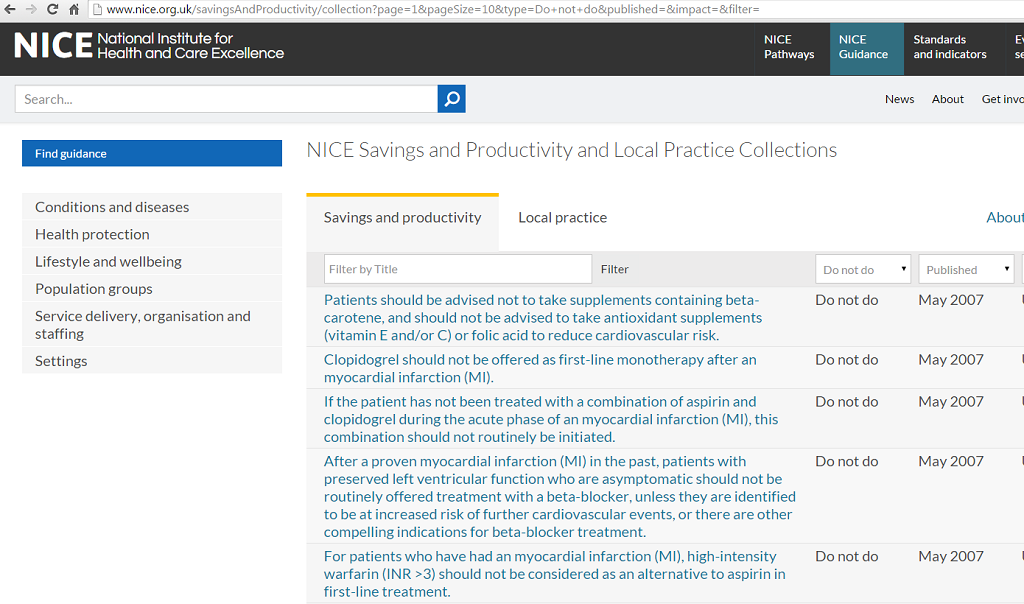Recomendación

Assessing risk of acute kidney injury
NICE ()
Identifying acute kidney injury in people with acute illness 1.1.1Investigate for acute kidney injury, by measuring serum creatinine and comparing with baseline, in adults with acute illness if any of the following are likely or present: chronic kidney disease (adults with an estimated glomerular filtration rate [eGFR] less than 60 ml/min/1.73 m2 are at particular risk) heart failure liver disease diabetes history of acute kidney injury oliguria (urine output less than 0.5 ml/kg/hour) neurological or cognitive impairment or disability, which may mean limited access to fluids because of reliance on a carer hypovolaemia use of drugs that can cause or exacerbate kidney injury (such as non‑steroidal anti‑inflammatory drugs [NSAIDs], aminoglycosides, angiotensin‑converting enzyme [ACE] inhibitors, angiotensin II receptor antagonists [ARBs] and diuretics) within the past week, especially if hypovolaemic use of iodine-based contrast media within the past week symptoms or history of urological obstruction, or conditions that may lead to obstruction sepsis deteriorating early warning scores age 65 years or over. [2013] 1.1.2Investigate for acute kidney injury, by measuring serum creatinine and comparing with baseline, in children and young people with acute illness if any of the following are likely or present: chronic kidney disease heart failure liver disease history of acute kidney injury oliguria (urine output less than 0.5 ml/kg/hour) young age, neurological or cognitive impairment or disability, which may mean limited access to fluids because of reliance on a parent or carer hypovolaemia use of drugs that can cause or exacerbate kidney injury (such as NSAIDs, aminoglycosides, ACE inhibitors, ARBs and diuretics) within the past week, especially if hypovolaemic symptoms or history of urological obstruction, or conditions that may lead to obstruction sepsis a deteriorating paediatric early warning score severe diarrhoea (children and young people with bloody diarrhoea are at particular risk) symptoms or signs of nephritis (such as oedema or haematuria) haematological malignancy hypotension. [2013] Identifying acute kidney injury in people with no obvious acute illness 1.1.3Be aware that in adults, children and young people with chronic kidney disease and no obvious acute illness, a rise in serum creatinine may indicate acute kidney injury rather than a worsening of their chronic disease. [2013] 1.1.4Ensure that acute kidney injury is considered when an adult, child or young person presents with an illness with no clear acute component and has any of the following: chronic kidney disease, especially stage 3B, 4 or 5, or urological disease new onset or significant worsening of urological symptoms symptoms suggesting complications of acute kidney injury symptoms or signs of a multi‑system disease affecting the kidneys and other organ systems (for example, signs or symptoms of acute kidney injury, plus a purpuric rash). [2013] Assessing risk factors in adults having iodine-based contrast media 1.1.5Before offering iodine-based contrast media to adults for non‑emergency imaging, investigate for chronic kidney disease by measuring eGFR or by checking an eGFR result obtained within the past 3 months. [2013] 1.1.6Before offering iodine-based contrast media to adults, assess their risk of acute kidney injury but do not delay emergency imaging. Be aware that increased risk is associated with: chronic kidney disease (adults with an eGFR less than 40 ml/min/1.73 m2 are at particular risk) diabetes but only with chronic kidney disease (adults with an eGFR less than 40 ml/min/1.73 m2 are at particular risk) heart failure renal transplant age 75 years or over hypovolaemia increasing volume of contrast agent intra-arterial administration of contrast medium with first-pass renal exposure. [2013] 1.1.7Include the risks of developing acute kidney injury in the routine discussion of risks and benefits of the imaging procedure. Follow the recommendations on shared decision making in the NICE guideline on patient experience in adult NHS services. [2013] Assessing risk factors in adults having surgery 1.1.8Assess the risk of acute kidney injury in adults before surgery. Be aware that increased risk is associated with: emergency surgery, especially when the person has sepsis or hypovolaemia intraperitoneal surgery chronic kidney disease (adults with an eGFR less than 60 ml/min/1.73 m2 are at particular risk) diabetes heart failure age 65 years or over liver disease use of drugs that can cause or exacerbate kidney injury in the perioperative period (in particular, NSAIDs after surgery). Use the risk assessment to inform a clinical management plan. [2013] 1.1.9Include the risks of developing acute kidney injury in the routine discussion of risks and benefits of surgery. Follow the recommendations on shared decision making in the NICE guideline on patient experience in adult NHS services.
Idioma:
Inglés
Especialidad:
Varias especialidades
Año Publicación:
2019
Tipo de Intervención:
Preventiva
Tipo de Recomendación:
Alto valor



